Traditional water harvesting methods
The knowledge of hydrology is deep rooted in the science of ancient India. Our ancestors applied the knowledge in water resource engineering. They designed and constructed dams and a variety of water structures much earlier than the consciously believed Greek, Roman or other ancient civilizations. Every region of our country had its own water harvesting techniques, reflecting the geographical peculiarities and cultural uniqueness of different communities.
Rajasthan, a large part of which is covered by the Thar Desert, has had a long tradition of water conservation. For instance builders of the famous Bundi and Chittorgarh forts had the vision of exploiting the natural catchments in the forts created by undulating hilltops. Rainwater was collected in several ways and water flowing down the hill slopes was also stored in a water body. Two pictures below of Bundi Fort illustrate it. Picture- 1 shows a water path i.e. rainwater flowing down the hill was purified by a jaal (sieve) between the two structures. It then flows into the water body and gets accumulated as seen in picture - 2.
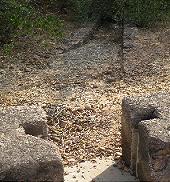
Pic.-1 |

Pic.-2 |
Talab/ Bandhis
Talabs were reservoirs. They could be natural, such as the ponds (pokhariyan) at Tikamgarh in the Bundelkhand region or could be man-made, such as the lakes in Udaipur. A reservoir area of less than five bighas was called a talai; a medium sized lake was called a bandhi or talab; bigger lakes were called sagar or samand. The pokhariyan served the purpose of irrigation and drinking. When the water in these reservoirs dried up, the pond beds were used for cultivation.
Johads
Johads, in Rajasthan, were small earthen check dams built to capture and conserve rainwater, thus improving percolation and recharging ground water1.
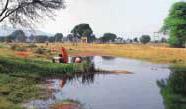
Pic.-3
Baoris / Bers
Baoris or bers were community wells, found in Rajasthan, that were used mainly for drinking. Most of them are very old and were built by banjaras for their drinking water needs. They could hold water for a long time because of almost negligible water evaporation.
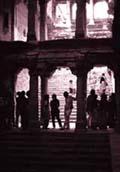
Pic.-4
Jhalaras
Jhalaras were man-made tanks, found in Rajasthan and Gujarat, essentially meant for community use and for religious rites but not for drinking. Often rectangular in shape, jhalaras have steps on three or four sides. They were ground water bodies which were built to ensure easy and regular supply of water to the surrounding areas.
The jhalaras collected subterranean seepage of a talab or a lake located upstream.
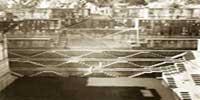
Pic.-5
Water Temples or ‘Step Wells’ Another most unique example for harvesting rainwater and providing water for drinking purpose in arid parts of our country was the step well.
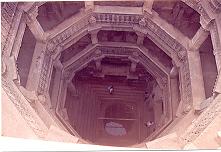
Pic.-6
Step wells are also called water temples of India. The idea to construct step wells was initiated due to the need to ensure water supply during the period of drought. Some of the step wells were dug very close to tanks to get drinking water throughout the year. Step wells are also called Vav, Vavadi, Bawdi, Bawri, Baoli, and Bavadi and can be found in Gujarat and Rajasthan.
Adalaj-Vav is a very popular step-well i.e. about 20 kms from Ahmdabad. It is made in the form of a temple that ends into a well. The well is about six storeys below ground level. Picture 6 illustrates the depth of the well.
Kunds
Kunds, covered underground tanks were developed for tackling drinking water problems. Usually constructed with local materials or cement, kunds were more prevalent in the western arid regions of Rajasthan, and in areas where the limited groundwater available is moderate to highly saline. In such conditions, kunds provided convenient, clean and sweet water for drinking. They were also prevalent in Gujarat and Uttar Pradesh.
There are many more such kunds that have met the water needs of the people of Rajasthan and other states over centuries. See picture below (Pic 7 is copyright Centre for Science and Environment or CSE)
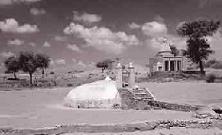
Pic.-7 |
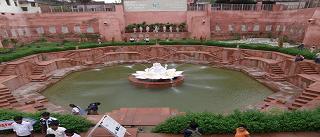
Pic.-8 Brahmkund in Vrindavan |